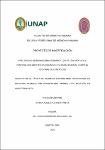Efectividad de Bupivacaína isobarica 0,2% vs 0.3% asociada a fentanilo en anestesia subaracnoidea para cesáreas, Hospital Regional de Loreto, 2022
Abstract
The technique of choice in cesarean sections is subarachnoid anesthesia, innovations have been made by using the dilutional technique, as well as the use of low doses of local anesthetics associated with intrathecal opioids for the advantages they offer by promoting rapid recovery of the patient and decreasing the frequency of occurrence of adverse effects. OBJECTIVE: To compare the effectiveness of isobaric bupivacaine 0.2% vs 0.3% associated with fentanyl in subarachnoid anesthesia for cesarean section at the Loreto Regional Hospital 2022. METHODS: Randomized retrospective controlled experimental study at the Regional Hospital of Loreto during the period January-December 2022, the sample will consist of a total of 56 patients divided into two groups who will undergo cesarean section. The technique to be used will be randomly assigned to each patient who meets the inclusion criteria; group 1 will be administered bupivacaine 0.2% and group 2 bupivacaine 0.3%, both concentrations associated with fentanyl. For the bivariate analysis of hemodynamic changes in both groups, the statistical significance of the values of blood pressure, heart rate and oxygen saturation recorded at different times will be analyzed and processed with the Kruskal-Wallis nonparametric test; the Chi-square test will be used to evaluate the relationship between onset time, latency time, total anesthesia time, level of sensory and motor blockade. Statistical tests will be significant at a value of p < 0.05. La técnica de elección en cesáreas es la anestesia subaracnoidea, se han hecho innovaciones al utilizar la técnica dilucional, así como el empleo de bajas dosis de anestésicos locales asociado a opioides por vía intratecal por las ventajas que ofrecen al promover rápidamente la recuperación de la paciente y disminuir la frecuencia de aparición de efectos adversos. OBJETIVO: Comparar la efectividad de bupivacaína isobárica 0,2% vs 0.3% asociada a fentanilo en anestesia subaracnoidea para cesáreas en el Hospital Regional de Loreto 2022. MÉTODOS: Estudio experimental controlado de tipo retrospectivo y aleatorizado en el Hospital Regional de Loreto durante el periodo Enero-Diciembre del 2022, la muestra estará conformada por un total de 56 pacientes divididas en dos grupos que serán intervenidas de cesárea. Se designará de manera aleatoria la técnica a utilizar a cada paciente que cumpla los criterios de inclusión, al grupo 1 se le administrará bupivacaína 0.2% y al grupo 2 bupivacaína 0.3%, ambas concentraciones asociadas a fentanilo. Para el análisis bivariado en los cambios hemodinámicos de ambos grupos se analizará la significancia estadística de los valores tanto de presión arterial, frecuencia cardiaca y saturación de oxígeno registrados en diferentes tiempos para ser procesados con la prueba no paramétrica de Kruskal-Wallis; para la valoración de la relación del tiempo de inicio, tiempo de latencia, tiempo total de la anestesia, nivel de bloqueo sensitivo y motor se utilizará la prueba de Chi-cuadrado. Las pruebas estadísticas serán significativas a un valor de p < 0.05.


